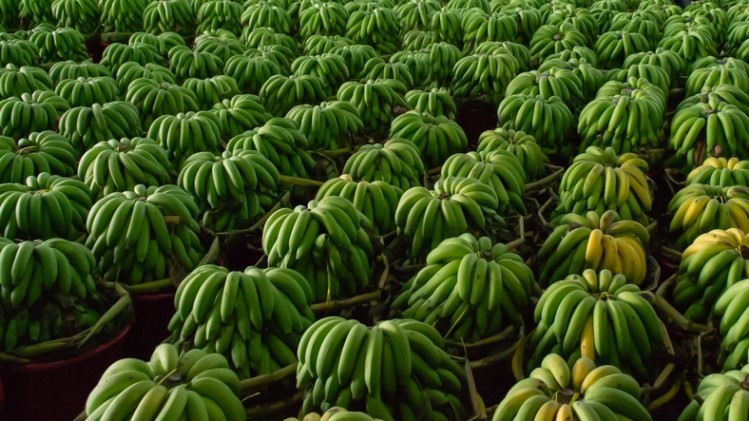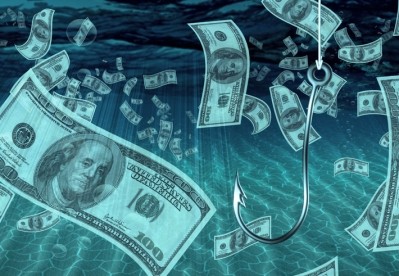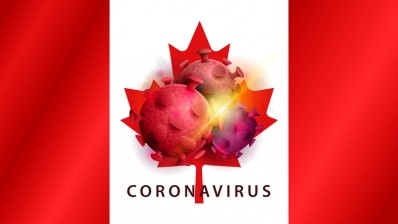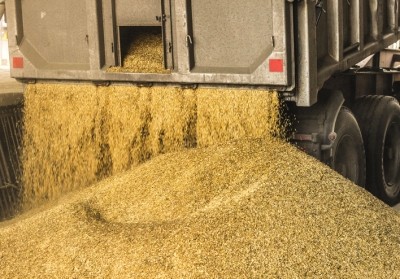Banana meal provides novel alternative in select aquaculture feeds

A team of researchers from multiple academic institutions in Brazil explored the use of banana meal in place of cornmeal in the diets of farmed juvenile tambaqui in a series of experiments. The study was published in the journal Aquaculture Reports.
“The aim of the present study was to evaluate the possibility of replacing part of the dietary CM [cornmeal] with WBM [whole banana meal] in a practical diet for tambaqui juveniles and to detect possible effects on growth performance, digestive enzyme activities, biochemical and hematological variables,” the researchers said.
In the first study, the researchers found that the energy apparent digestibility coefficients (ADC) were higher in the whole banana meal (WBM) feed than in the reference diet.
The WBM was digestible for the fish, they said. Fish growth was maintained when up to 8% of WBM was added to diets, but higher levels may be linked to hyperglycemia though not liver damage.
It was possible to see negative results if more than 16% of WBM was used to replace cornmeal, they said.
“Values above 16 % WBM included in the diet are not recommended,” the researchers said. “We recommend the replacement of 8% of CM by WBM in a practical diet for tambaqui.”
Evaluating alternative feed ingredients
In Brazil, the second most commonly raised fish species is the tambaqui – a native species to the Amazon Basin – as the fish does well in intensive rearing systems, the researchers said. In 2017, about 88,500 tons of fish were produced, and it is raised in several other countries in Central and South America.
In its natural environment, the fish is an omnivore and it can eat multiple protein and energy sources, they said.
“Proper utilization of carbohydrates in the fish diet contributes to directing the use of proteins for fish growth, as well as reducing the elimination of nitrogenous residues,” the researchers said. “In addition, the use of carbohydrates, when balanced with proteins and lipids in fish diets, may reduce the amount of protein in the diet formulation, reducing feed cost, as protein is one of the most expensive dietary items in the fish diet.”
One of the most common energy ingredients used as a carbohydrate source is cornmeal (CM), they said. The ingredient has a high digestibility for omnivorous and herbivorous fish.
However, several alternatives to cornmeal have been explored including fruit, they said. Previous research looked at including mango in tilapia, tambaqui and camu diets, licuri in tambaqui feed or banana in diets for African catfish and pirapitinga.
Why banana meal?
Banana is a fruit raised in most tropical countries and provides an important nutritional source for human populations, the researchers said. It also may have a role in aquaculture feeds.
“Brazil produced around 7m tons in 2017 and it is one of the largest banana growers in the world,” they said. “According to the FAO (2015), fruit and vegetable losses in South America are approximately 40–50%. This high waste, when evaluated together with the high perishability of this fruit, demonstrates that there is a large supply of unused banana for human consumption that could be used as food in aquaculture.”
The chemical composition of banana meal ranges from “61–76.5% starch, 19–23% amylose, 2.5–3.3% protein, 4–6% moisture, 0.3–0.8% lipids, 2.6–3.5% ash and 6–15.5% crude fiber,” they said. The use of whole banana meal as a carbohydrate source could provide an “economically viable” alternative ingredient for fish diets and reduce the environmental effect of discarded waste bananas.
However, understanding the digestibility of a plant-based feed ingredient is important before it can be used in fish diets because several plant-based inclusions have anti-nutritional factors that can harm fish health, they said.
“The banana contains some anti-nutritional factors like tannins, oxalate and phytate amongst others which could induce adverse effects like depressed growth and reduced feed efficiency in fish,” the researchers said. “However, it is difficult to make firm conclusions regarding specific plant secondary metabolites causing deleterious effects and their threshold levels in fish diets, as several physical, chemical and biological factors may mitigate the adverse effects of these anti‐nutritional factors.”
Bananas also provide high levels of potassium, crude fiber, amino acids, protein and poly-unsaturated fatty acids, they added.
There is little research evaluating the use of banana meal in fish diets while looking at digestibility, changes to growth performance and metabolic and physiological variables, they said.
Feed trial details
Feeding trials were done in two stages, the researchers said.
In the first trial, commercially available bananas were included in an experimental diet that was 70% cornmeal and 30% WBM. Fish in the trial were given the test feed or a reference diet made using standard ingredients for a 10-day period following acclimation.
Fecal matter was collected and analyzed for apparent digestibility coefficients (ADC) of crude energy, crude protein and dry matter, they said.
In the second trial, fish received one of five diets for a period of 45 days, the researchers said. The diets included a control with no banana meal and diets where WBM replaced 8, 16, 24, 32% of the cornmeal used in the feed.
The diets were checked for phenol content and flavonoids, they said. Fish were checked for growth performance including weight gain (WG), specific growth rate (SGR), carcass yield and survival.
On day 45, a selection of fish on each diet was harvested to collect blood samples for analysis along with the liver and intestinal tract, they said.
Results
In the digestibility trial the ADC for crude protein, crude energy and dry matter were more than 90%, the researchers said. The crude energy ADC for WBM was higher than that in the reference diet.
No mortality was found in either trial, they said.
In the second trial, adding increasing amounts of WBM linearly influenced growth performance and tended to reduce final weight, WG, CY [carcass yield] and SGR, the researchers said. “Based on linear regression, tambaquis that received over 16 % WBM as a replacement for CM had decreased growth performance.”
“In addition, fish fed a 32% WBM diet had a significantly lower WG and SGR than the group fed the 8% WBM diet,” they said. Fish eating the 8% diet tended to have the heaviest final weight and weight gain, while most fish had similar carcass yield.
Fish receiving the 32% WBM diet had increased levels of blood glucose and hepatic glycogen compared to fish on the control or 8% diets and lower plasma cholesterol levels than control group fish, they said. Fish on the control and 8% diet had the highest plasma triglyceride concentrations.
“Linear regression analysis showed that the dietary increase in WBM caused a decrease in Hct [hematocrit], Hb [hemoglobin], MCV [mean corpuscular volume] and MCH [mean corpuscular hemoglobin] and an increase in Ery [erythrocyte] levels in tambaquis,” they said. “In addition, fish fed the 32% WBM diet had significantly higher Ery and lower MCV and MCH levels compared with the treatments with 0 or 8% WBM as replacement for CM in the diet.”
Source: Aquaculture Reports
Title: Effects of whole banana meal inclusion as replacement for corn meal on digestibility, growth performance, hematological and biochemical variables in practical diets for tambaqui juveniles (Colossoma macropomum)
Authors: A.F. e Silva, C.E. Copatti, E.P. de Oliveira, H.C. Bonfá, F.V.S.T. de Melo, A.C.S. Camargo, J.F.B. Melo
DOI: published online before print: doi.org/10.1016/j.aqrep.2020.100307













